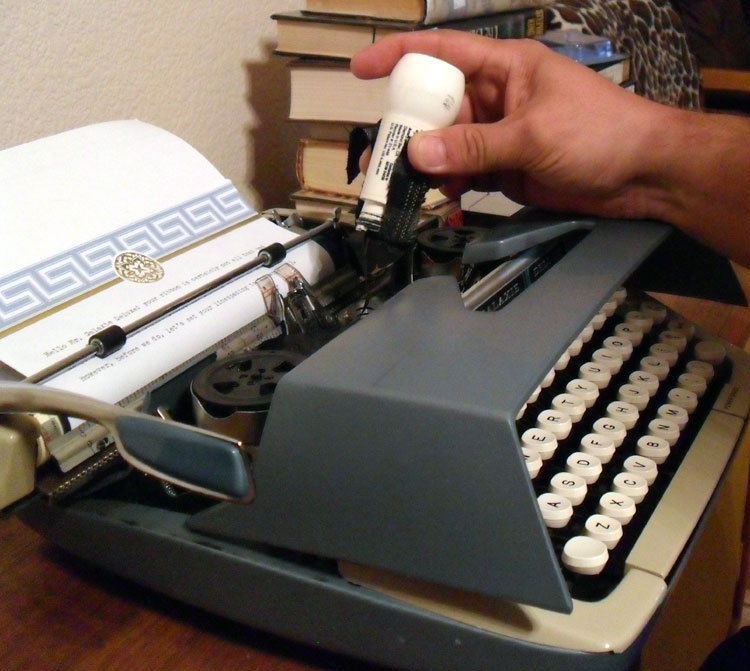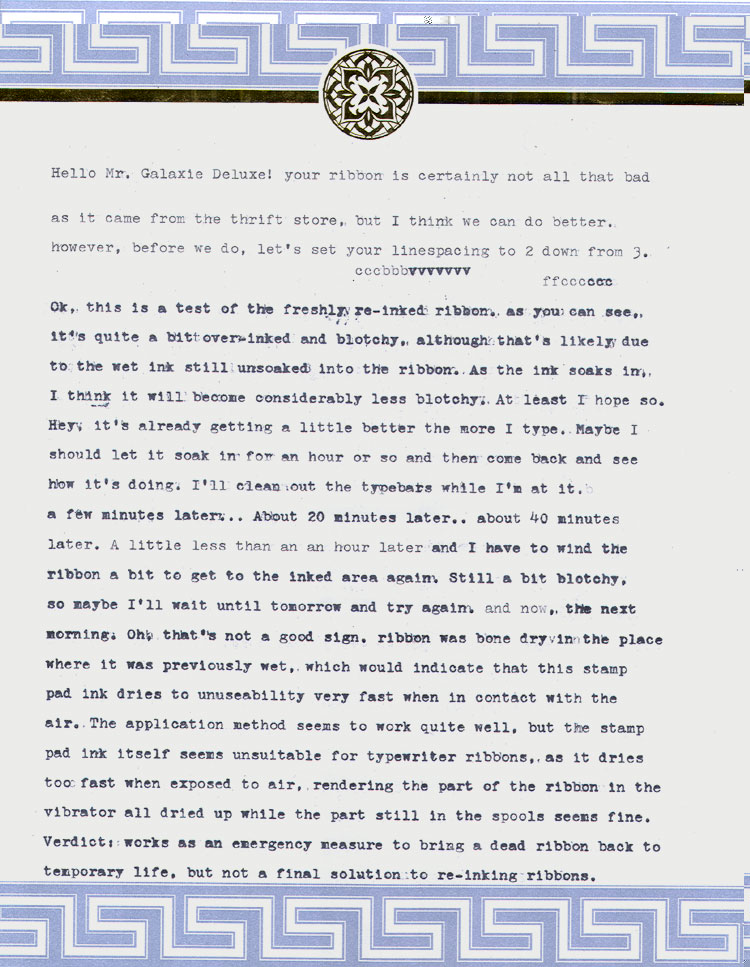
The tools of the experiment: $2 Carter's stamp pad re-inker and a thin strip of cloth. The K.I.S.S Method.

Keep ribbon in typewriter, but pull it out of the vibrator and rewind it all the way to one end. Then take the ribbon and hold it firmly to the business end of the re-inker using the strip of cloth in such a way that you can lightly squeeze the re-inker and you wind the ribbon slowly back through it. Excess ink gets soaked into the cloth, and I didn't have any drips. When done, just thread the newly inked ribbon back into the vibrator and flip the directional switch so it feeds the ribbon back. I actually wound the ribbon back and forth between the spools a couple of times to help the ink soak in.

Thanks for this post, Ted. Very helpful for me.
Interesting experiment. The typewriter ribbon ink (and ink for old ink rollers and ink pads) seems to have a very specific consistency. As you say, it has to stay fresh on the ribbon but then must dry right away on the paper. Chemically tricky, I suppose.
Interestingly, I found this PDF bibliography of a study of typewriter inks. It seems that typewriter inks are oil-based.
I do have access to offset printing inks, both oil and rubber-based. I may try further experiments in that area later. If successfull, it could mean that you could re-ink ribbons in pretty much any color under the rainbow, including metallics and Pantone colors.
Update: also found this: How to make typewriter inks.
Couldn’t resist mentioning oil-based inks seeing that comment.
It would have to be oil based or it would dry up pretty fast being exposed to the air even overnight, plus, when you accidentally smear your inky fingers on the typewriter it feels oily and you can wipe it off and it leaves not a trace. (Not that that means it’s oil based but maybe?)
The fact that typewriter inks are oil-based makes a lot of sense to me now. I’ve always had trouble cleaning dried ink off of typebar heads with rubbing alcohol. It took a lot of work. Then I switched over to naphtha, which is apparently an oil solvent (not sure if that’s the correct technical term for it), and the ink just comes right off.
We used to use a very tacky ink in college for proofing letterpress and wood/lino cuts. It was always referred to as “jobbing black”. It had the useful characteristic of never really drying. Yo could try that if you have access to any. I’d be inclined to roll it very sparsely, on an old litho plate maybe, and then roll it over a test length of ribbon. Another ink which has similar tackiness (therefore easily rolled) and has the same non-drying property, is ballpoint pen ink. You might need quite a few to get a reasonable quantity. If it must be dabbed onto the ribbon more or less in-situ you could try thinning either with a drop of white spirit. I tried the ball-point pen ink trick a good few years ago and it worked reasonable well in reviving a ribbon. Of course, the tiny amount that ends p on the paper will dry eventually.
Very interesting… I heard of mixing some quality ink (quink or so) with WD40 to get the oily factor up. I’ve been speculating on a few experiments in this department. *subscribed*
Hi!
Couldn’t seem to find any help on the Internet regarding this whatsoever.
Can I re-ink a previously black typewriter ribbon with BLUE stamp pad ink or is there some rule of not changing up the colours?
Kindly, let me know ASAP.
I tried re-inking a black t/w ribbon with an old bottle of red stamp pad ink and was pleased with the resulting dark-red typing. However, the ribbon seemed to become drier before too long. Don’t know whether the red ink was too old or whether there was insufficient oil on the ribbon. If blue s.p.ink is applied to a black ribbon, u will probably get blue-black typing. I see no objection, but am no authority.